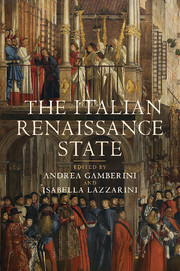Book contents
- Frontmatter
- Contents
- Notes on the contributors
- Note on translations and usage
- Map
- Introduction
- Part I The Italian states
- Part II Themes and perspectives
- 12 The collapse of city-states and the role of urban centres in the new political geography of Renaissance Italy
- 13 The rural communities
- 14 Lordships, fiefs and ‘small states’
- 15 Factions and parties: problems and perspectives
- 16 States, orders and social distinction
- 17 Women and the state
- 18 Offices and officials
- 19 Public written records
- 20 The language of politics and the process of state-building: approaches and interpretations
- 21 Renaissance diplomacy
- 22 Regional states and economic development
- 23 The papacy and the Italian states
- 24 Justice
- Bibliography
- Index
18 - Offices and officials
Published online by Cambridge University Press: 05 August 2012
- Frontmatter
- Contents
- Notes on the contributors
- Note on translations and usage
- Map
- Introduction
- Part I The Italian states
- Part II Themes and perspectives
- 12 The collapse of city-states and the role of urban centres in the new political geography of Renaissance Italy
- 13 The rural communities
- 14 Lordships, fiefs and ‘small states’
- 15 Factions and parties: problems and perspectives
- 16 States, orders and social distinction
- 17 Women and the state
- 18 Offices and officials
- 19 Public written records
- 20 The language of politics and the process of state-building: approaches and interpretations
- 21 Renaissance diplomacy
- 22 Regional states and economic development
- 23 The papacy and the Italian states
- 24 Justice
- Bibliography
- Index
Summary
Introduction
One of the main characteristics of the developing state, in terms of its internal organisation, is the importance acquired by the prince's officials. This, along with the development of the art of war and the growth of diplomacy, is one of the greatest novelties of the Renaissance state. ‘[T]he state is now concentrated about [. . .] two poles: the power of the sovereign and the hierarchy of “officials”’ – or so Federico Chabod put it in 1956, when the binomial ‘state–officials’ was first introduced in contemporary Italian historiography. But what state and which officials was Chabod talking about? And what has changed in historians’ interpretations of the evidence over the past fifty years? In Chabod's view, the world in which officials assumed importance belonged to a precise time, and it took place within a particular political geography. Chabod's officials were characteristic of the ‘state of the Renaissance’, which he thought existed from the middle of the fifteenth century to the middle of the sixteenth. The Italy he was concerned with was above all princely and mainly Lombard, with a Milanese and Sforza bias. The result of Chabod's influential work was what might be called an ‘Italian way’ of studying officials in the later Middle Ages and early modern period, and I should like to begin this overview by pointing to three problematic aspects of this scholarship as it has developed subsequent to Chabod.
- Type
- Chapter
- Information
- The Italian Renaissance State , pp. 368 - 384Publisher: Cambridge University PressPrint publication year: 2012
- 3
- Cited by



